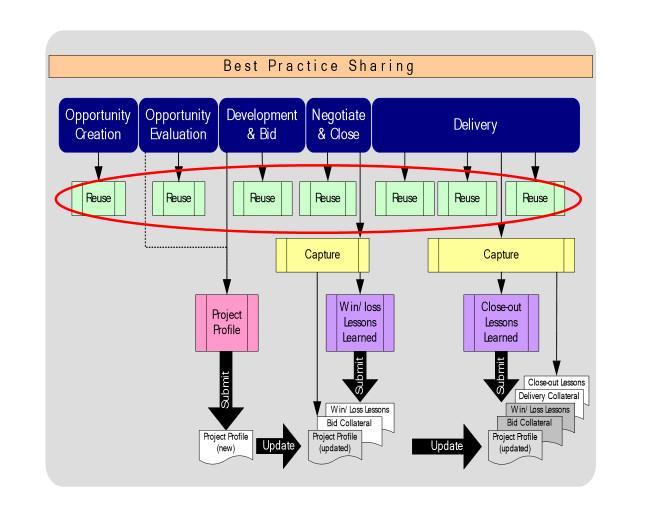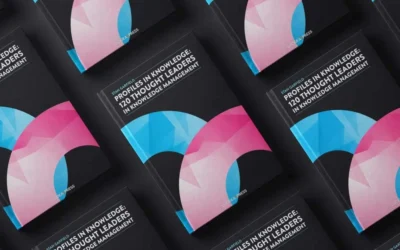KM Component 15 – Knowledge Reuse Process

Stan Garfield
In a KM context, reuse is putting to practical use the captured knowledge, community suggestions, and collaborative assistance provided through knowledge sharing.
Reuse is the other side of capture. It represents the demand for the knowledge supply resulting from a knowledge capture process. For reuse to succeed, there must be a good supply of reusable content, it must be easy to find, and it must be in a format suitable for reuse. Demand-driven knowledge management takes advantage of networks, supply, analysis, and codification. It is stimulated by dissemination and enabled by making it easy to find resources.
Reuse is applying and adapting existing knowledge and content to new situations. Reuse is the core process of knowledge management. Reusing and adapting Red Motley’s famous quote “Nothing happens until somebody sells something,” I coined the maxim Knowledge management doesn’t happen until somebody reuses something.
Even if every possible document and knowledge object is captured and stored, there is no resultant benefit unless there is significant reuse of that content. Knowledge management aims to keep the supply and demand for knowledge in balance through processes, procedures, and policies for both.
Reusing what others have already learned, created, and proved can save time and money, minimize risk, and increase effectiveness. It creates a demand for knowledge. Thus, knowledge capture and reuse processes are often combined into a single process that creates both the supply and the demand for knowledge. A policy defining what must be captured and reused, and a related procedure specifying the steps to follow, should be created to implement effective reuse.
In addition to the reuse of captured documents, other reuse processes can take advantage of advice offered by communities and knowledge help desks. Many of the other KM components lend themselves to reuse, including people (training, documentation, user assistance), process (methodologies, lessons learned, proven practices, valuation, storytelling), and technology (repository content, threaded discussion content, search results, e-learning content).
The reuse of ideas, documents, and expertise is one of the key benefits of knowledge management. Once you have developed an effective process, you want to ensure that others use the process each time a similar requirement arises. If someone has written a document or created a presentation that addresses a recurring need, it should be used in all future similar situations.
When members of your organization have figured out how to solve a common problem, know how to deliver a recurring service, or have invented a new product, you want that same solution, service, and product to be replicated as much as possible. Just as the recycling of materials is good for the environment, reuse is good for organizations, because it minimizes rework, prevents problems, saves time, and accelerates progress.
Reusing knowledge in repositories allows decisions to be based on actual experience, large sample sizes, and practical lessons learned. This can be done by searching for existing content and contacts from previous projects and employing as much as possible in new ones. Solutions can be reused by asking and answering questions, applying shared insights, and retrieving posted material.
Discovery processes enable reuse from existing sources of information, including systems, data warehouses, and libraries. In most organizations, there are information systems, transaction processing applications, and databases that are used to run the business. There is data captured in these systems that can be reused to distill trends, answer queries, and support decision making. And this can be done without the need to capture data redundantly. For example, if customer purchase information is entered into the order processing system, it can be fed to a data warehouse for reuse by all departments.
10 Ways to Encourage Reuse
- Nurture a knowledge-sharing culture in which knowledge reuse is valued over reinvention.
- Set a goal for reusing content and experience from bids and projects, including sales collateral, proposals, service guides, project documents, and software source code.
- Ask the following question in individual performance reviews: What content did you reuse in the course of doing your job?
- Require all project teams to reuse standard, institutionalized knowledge from previous, similar projects.
- Implement a reuse process for proposals, including a proposal wizard for automatically generating new proposals by reusing boilerplate and cleansed content from previous proposals.
- Institutionalize the application of lessons learned.
- Facilitate the replication of proven practices.
- Measure reuse by capturing the percentage of reuse in proposals and projects, the number of lessons learned applied, and the number of proven practices replicated.
- Capture the value of reuse by requesting it as part of user surveys.
- Report regularly on the amount and value of reuse.
Examples of Reuse Methods
Here are five KM methodologies for reusing knowledge.
- Appreciative Inquiry is the co-evolutionary search for the best in people, their organizations, and the relevant world around them. In its broadest focus, it involves systematic discovery of what gives life to a living system when it is most alive, most effective, and most constructively capable in economic, ecological, and human terms.
- Positive Deviance is based on the observation that in every community there are certain individuals or groups whose uncommon behaviors and strategies enable them to find better solutions to problems than their peers, while having access to the same resources and facing similar or worse challenges. It is an asset-based, problem-solving, and community-driven approach that enables the community to discover these successful behaviors and strategies and develop a plan of action to promote their adoption by all concerned.
- Checklist is a job aid used to reduce failure by compensating for potential limits of human memory and attention. It helps to ensure consistency and completeness in carrying out a task.
- Peer Assist is used to learn from the experiences of others before embarking on an activity or project. It brings together a group of peers to elicit feedback on a problem, project, or activity, and to draw lessons from the participants’ knowledge and experience.
- Most Significant Change is the collection of significant change stories emanating from the field level, and the systematic selection of the most significant of these stories by panels of designated stakeholders or staff. Once changes have been captured, people sit down together, read the stories aloud, and have in-depth discussions about the value of these reported changes.

Stan Garfield
Please enjoy Stan’s additional blog posts offering advice and insights drawn from many years as a KM practitioner. You may also want to download a copy of his book, Proven Practices for Implementing a Knowledge Management Program, from Lucidea Press. And learn about Lucidea’s Inmagic Presto and SydneyEnterprise with KM capabilities to support successful knowledge curation and sharing.
For a case study on how reuse was integrated into the project lifecycle at HP, see Chapter 15 in Proven Practices for Promoting a Knowledge Management Program. Here is a diagram showing the stages at which reuse was required: 
Similar Posts
Only You Can Prevent Knowledge Loss: How to Practice “Knowledge Archaeology”
An overview of ways in which knowledge is lost, with examples of how to perform knowledge archaeology to recover and restore it.
Ready to Read: Profiles in Knowledge: 120 Thought Leaders in Knowledge Management
We are pleased to announce that Stan Garfield’s new book, Profiles in Knowledge: 120 Thought Leaders in Knowledge Management, is now available from Lucidea Press.
Lucidea’s Lens: Knowledge Management Thought Leaders Part 92 – Jay Liebowitz
Jay Liebowitz is a professor, consultant, author, and editor. His research interests include knowledge management, data analytics, intelligent systems, intuition-based decision making, IT management, expert systems, and artificial intelligence.
Lucidea’s Lens: Knowledge Management Thought Leaders Part 91 – Frank Leistner
The late Frank Leistner was the former Chief Knowledge Officer for SAS Global Professional Services, where he founded the knowledge management program and led a wide range of knowledge management initiatives up until 2012.




Leave a Comment
Comments are reviewed and must adhere to our comments policy.
0 Comments